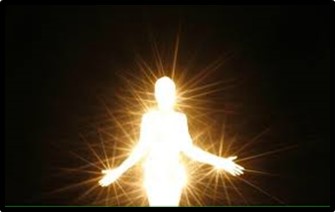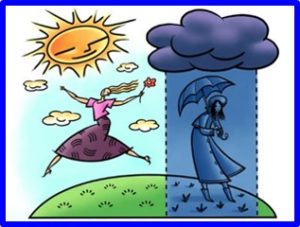Monday Author: Susanne Skinner
Every mile is two in winter ~ George Herbert
It’s winter. I am cold, have less energy and carbs have become my new best friend.
 We are in the shortest, coldest, and darkest days of the year and I can’t wait for them to end. Unfortunately, the Spring Equinox is 57 days away. I am stuck in the seasonal slump of gray days and moody behavior .
We are in the shortest, coldest, and darkest days of the year and I can’t wait for them to end. Unfortunately, the Spring Equinox is 57 days away. I am stuck in the seasonal slump of gray days and moody behavior .
Below-freezing temperatures have curtailed my walking group, lowered my energy and motivation and started a love affair with bad carbs. I have forgotten what warm feels like.
The winter blues have descended on me and I know I am not alone.
Mother Nature Strikes
Mother Nature’s moods affect one in four of us. As days get shorter and colder, we crave comfort foods and experience a drain on our energy that will magically disappear as we get closer to spring. The further you are from the equator, the higher your risk of being affected.
Winter blues are not a product of winter alone. They are also linked to stressful holidays, the reminder of loved ones no longer with us, and the flu season. This creates a form of seasonal depression that many people struggle with, including me.
While winter is upon us we can take simple and positive steps to beat—or significantly reduce—the winter blues.
Let the Light In
 Lack of sunlight affects the hypothalamus, which in turn affects the formation of neurotransmitters; chemicals brain cells use to communicate with each other.
Lack of sunlight affects the hypothalamus, which in turn affects the formation of neurotransmitters; chemicals brain cells use to communicate with each other.
Winter’s shorter days and reduced sunlight disrupt circadian rhythms and throw our body clock out of whack. The solution is to get as much sunlight as possible. Light enters through the eye, which activates and balances the body’s internal clock.
The key is sunlight. Natural sunlight is in short supply in many areas of the country and the Polar Vortex has kept us inside. Those with a higher tolerance for cold temperatures will venture outdoors and might be less susceptible to winter depression. Those further south are less affected, as sunlight is plentiful.
The Benefits of Vitamin D
Vitamin D is an essential nutrient, created when your skin is exposed to sunlight. When you get less sunshine, you have less Vitamin D. Natural Vitamin D can be made only when the UV index—the measure of the sun’s radiation reaching the earth—is higher than 3 (on a scale from 0 to 11). In North America and Europe, this happens only during the summer months. An estimated 77% of Americans have subpar levels of Vitamin D in winter.
Research suggests that when your body is Vitamin D deficient you experience a drop in serotonin, a characteristic of seasonal depression. Serotonin is called the happiness molecule, as it affects moods, learning, memory, appetite regulation, and sleep.
People experiencing winter depression often have low levels of serotonin and elevated levels of melatonin. Your doctor can test you and either prescribe a high-dose supplement or suggest an over-the counter-dosage.
The brain’s pineal gland produces melatonin every night when it starts to get dark. People affected by winter blues produce higher than normal amounts of melatonin and lower levels of dopamine and norepinephrine. When they are in balance they help you feel energized, and motivated.
A simple 15-minute walk is a quick fix that increases and rebalances feel-good brain chemicals like serotonin, dopamine, norepinephrine, and endorphins.
Seasonal Affective Disorder
Some people have an extreme form of winter blues known as SAD or seasonal affective disorder. It is one of the most pervasive types of depression and strikes during the darker months. Symptoms range from lack of motivation and trouble focusing, to full-blown depression. Women are four times more likely to be diagnosed than men.
 Some people respond to light therapy, which involves sitting in front of a special source of bright light each day. Light boxes filter out most or all ultraviolet rays, reducing melatonin production and shifting circadian rhythm back to normal, emulating the longer days of summer,
Some people respond to light therapy, which involves sitting in front of a special source of bright light each day. Light boxes filter out most or all ultraviolet rays, reducing melatonin production and shifting circadian rhythm back to normal, emulating the longer days of summer,
Normal indoor lighting has no effect, no matter how bright it is. SAD lights, also called circadian lamps, emit at least 2500 lux (units of light) and block UV rays.
Symptoms of the Winter Blues:
To meet the medical criteria for SAD, you must experience these symptoms seasonally for two years:
-
- Carbohydrate and sugar cravings
- Fatigue and drop in energy
- Tendency to sleep more
- Weight gain
- Social withdrawal
- Persistent sadness
- Irritability
- Lack of motivation
- Sleep disturbances
- Trouble focusing
- Lower immunity
Based on the severity of these symptoms your doctor can recommend treatment options.
Practical Suggestions for Winter Blues
 Establish daily practices that help offset the negative effects of winter:
Establish daily practices that help offset the negative effects of winter:
-
- Eat Smarter: Winter blues generate cravings for sugar and refined carbohydrates. Chose a diet rich in vegetables, fruit, protein, healthy fats and carbohydrates.
- Exercise: Move more. Exercise increases resilience to stress, and research shows it can relieve depression and anxiety.
- Listen to Music: Music affects the emotional and intellectual parts of the brain and triggers the feel-good chemical dopamine. It helps calm your nerves, reduce stress and pump up your energy.
- Wear Bright Colors: Dark colors are depressing. Vibrant colors promote joy, increase focus and lift your spirits.
- Change your Mind Set: Embrace winter. The Danish call it hygge (pronounced hooga) and treat it as a time to slow down, enjoy your home and spend quality time with friends and family.
- Get Outside: Even in the depths of winter Mother Nature is an anti-depressant. Fifteen minutes outdoors improves focus, reduces symptoms of SAD, and lowers stress levels.
- Stay Connected: Get out, reach out, invite people in. Volunteer. Laugh with friends.
- Keep Your Mind Active: Stay involved. Focus on a short-term project or goal, read a book, try something new, plan a vacation.
Appreciate the quiet, peace and restorative nature of winter. All living things need rest and rejuvenation.
Spring is Coming.

Yeah, you don’t have to just use a light box anymore either. You can now buy “full spectrum” LED light bulbs in A19 or BR30 configurations to do much of the same in the winter months. The only down side to these bulbs is that they tend to be very bright and on the “blue-ish” side. Here’s an example web-site that might be useful:https://www.fullspectrumsolutions.com
There are others as well, as you would expect, so shop around first.
I’ve suffered with SAD for years. I’ve overcome it in many of the ways you suggested. I’d add a light box.
It resets your internal clock. SAD is mostly a result of the shorter days. You don’t look directly at it. You start out at 5 minutes and work your way up to 15 if needed. I used to turn it on while I made breakfast.
It works by emulating what sunlight does for us without the harmful UV rays. Think about it. In the summer when the sun is plentiful you feel lighter. Cope better. And enjoy life more. Many people can benefit immediately from the use if a light box. No drugs. Just light. It dilates your eyes and tricks your mind into thinking it’s getting more sun. It worked for me. But I caution you to start slow as this does reset your internal clock. More is not better in this case. Start at 5 minutes. You may or may not need to work up to 15 minutes.
I got mine from Northern Lights. I don’t use it anymore since I have changed many things in my life as a result of having SAD. I used the time I was using the light to slowly adjust my lifesyle for more permanent change and it worked.
Exercise is great. Getting outside and hopefully doing something fun in the snow helps. Airing out your house works too. Diet is good but can lead to a back slide if you obsess over it. Hope this helps